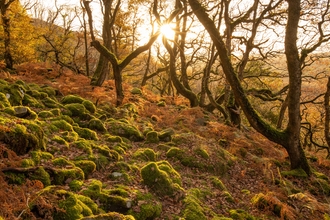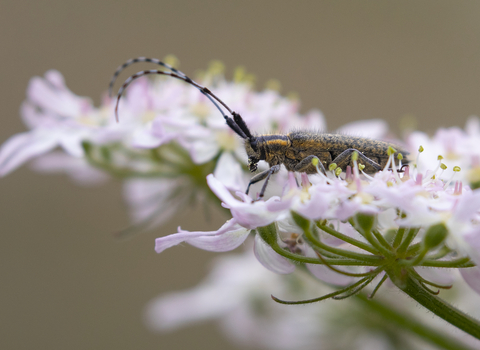Warwickshire Wildlife Trust’s Natural Capital Assessment Partnership team (a partnership including the Trust and 8 regional local authorities) have put together a State of Habitats 2025 report for Warwickshire, Coventry and Solihull. The data in the report show us the overall diversity of habitats, where different habitats are found and the total area of each type. This is vital information as there are competing pressures on limited available land.
This area is a special place, home to diverse species of plants and animals. Yellow archangel adds a splash of sunshine yellow to woodlands, just as the bluebells are finishing. Delicate quaking grass and harebells can be spotted in wildflower-rich grasslands. The iconic ‘popcorn’ berries of spindle, a plant characteristic of ancient woodland, are enjoyed by birds in autumn. These plants all contribute to the vibrant tapestry of colour and life that make up the region’s habitats. In turn they provide the building blocks for other life.
But many habitats are being squeezed by human activity. Understanding which habitats are where, can help prioritise those that most urgently need protecting, the best areas for new habitat creation and where habitats can be joined up for wildlife to move around the landscape. Going forward, this habitat baseline will show how habitats are changing over time.
Read on to find a summary of the report, or download the full report here.
Listen and learn
If you prefer an audio format listen to Ian Jelley, Director of Landscape Recovery, in conversation with Bob Hockenhull about the report and what it means for Warwickshire’s wildlife.
©Philip Precey
30 by 30
The Trust has committed to working for ‘30% of land in recovery, protected and connected for nature by 2030’. The report estimates how close the region is to meeting this: just under halfway there. Approximately 34k hectares of habitat need to be created in the next 5 years, an area about three times the size of Coventry!
Protected sites
The region has 67 Sites of Special Scientific Interest, designated and protected at a national level for their natural value1. There are also 667 Local Wildlife Sites, which are some of the most important sites for nature locally. Local Wildlife Sites are not legally protected, so specific management can’t be enforced, but they are protected from development.
Breakdown by habitat type

Bruce Shortland
Grassland
Only 3% of the region is wildlife-rich grassland with distinct wildflower communities. To put that into perspective, 4% of the region is made up of amenity grassland which includes sports pitches and other recreational grassland with very little wildlife value2. There are more sports pitches and turf areas than valuable wildlife-rich grasslands.
These wildlife-rich grasslands are at risk from development or tree planting schemes. While planting new trees and forests is great, it’s important to create the right habitat in the right place. New woodland creation should not be at the expense of valuable grasslands.
Heathland
Heathland is one of the rarest habitats in the region. There are only 10ha left, just under half the size of the indoor area of the NEC in Birmingham3. Only very small patches are left in places like Baddesley Common. In the past, much larger areas of heathland were present as shown through place names like ‘Dunsmore Heath’.

Sarah Barnsley
Wetlands
Wetlands are also some of the rarest habitats, covering only 1% of the region. Arable crops in the region cover an area nearly 500 times bigger than the area of wetland habitat. This figure speaks for itself in terms of the importance of protecting the remaining wetlands, home to species like reed bunting and common tern.
Hedgerows
Hedgerows as a habitat punch way above their weight. When managed well, they provide features of different habitat types: woodland, grassland and scrub. This is why they are great for many species. They connect larger habitat patches and allow wildlife to move about the landscape looking for food, shelter and expanding their home ranges.
There are 10,733 km of hedgerow across the region. Stretched out in a line, they would stretch about a quarter of the way around the planet!5
Learn more about hedgerows by visiting our blog: Wildlife and folklore of the humble hedge.

Ben Hall / 2020VISION
Woodland
Just over 7% of Warwickshire, Coventry and Solihull is covered by woodland and parkland habitats. This compares to 10% across England as a whole4.
Woodlands provide important habitat for many species. They are an important source of nectar and pollen for pollinators and other insects and provide nesting and foraging habitat for many birds, mammals and reptiles.
Read more about ancient woodland in our blog: How to spot ancient woodland during your autumn walk.
Urban areas
Warwickshire, Coventry and Solihull are very urbanised. Satellite imagery shows 9% of the region is made up of manmade features like buildings and roads6,7. Urban areas can be wildlife-rich too. Gardeners can give a helping hand by embracing a bit of ‘untidiness’, for example by leaving piles of dead wood or creating a compost heap for wildlife like hedgehogs and slow worms to enjoy. Mini wildlife ponds can be created in gardens or even on balconies and swift bricks or other bat and bird nesting boxes can be installed.

Russell Savory
Improved grassland and arable farming
26% of the region is made up of agriculturally improved or species-poor semi-improved grasslands. ‘Agriculturally improved’ means grasslands managed to increase farming productivity, for example through applying fertilisers.2 They have sadly lost most of their plants and wildlife. Species-poor semi-improved grasslands are the stage between wildlife-rich and agriculturally improved grasslands. They still have some wildflower species and value for wildlife but have lost a lot of their diversity2. They can be restored with the right management.
41% of the region is used for farming crops. As it covers such a large area, farmed land can be part of the solution to reversing wildlife declines. Many farmers are already taking action. Warwickshire Wildlife Trust’s agricultural advice team support farmers in a range of activities, from creation of on-farm habitats such as hedgerows and meadows, to providing advice on soil health or sustainable grazing practices.
Find out more

Wildlife and folklore of the humble hedge
Did you know there are 10,377km of hedgerow across Warwickshire? Find out more about how how hedgerows provide for wildlife.
Why is a diversity of habitats important?
The last decades have seen a move toward landscape-level conservation rather than solely focusing on individual habitats or species. So…

How to spot ancient woodland during your autumn walk
Woodland habitat provides an abundance of nectar for pollinators, as well as habitat for fungi, lichen and many insects. Here's…
References
- Natural England. Sites of Special Scientific Interest (England) (2024 Version) [Data set – Open Govt license]. Natural England, 2024.
- JNCC. Handbook for Phase 1 habitat survey – A technique for environmental audit, 2010 edition. Peterborough: Joint Nature Conservation Committee, 2010.
- NEC. 2016 Factsheet. [Online]. 2016. [Accessed 24/07/2025]. URL: https://www.thenec.co.uk/media/1294/nec-factsheet.pdf
- Forest Research. Chapter 1 Woodland Area & Planting. In: Forest Research. Forestry Statistics 2023. Midlothian: Forest Research, 2023.
- Cool Cosmos. How large is Earth? [Online]. 2025. [Accessed 24/07/2025]. URL: https://coolcosmos.ipac.caltech.edu/ask/57-How-large-is-Earth
- Spottitt. About Us. [Online]. 2025. [Accessed 24/07/2025]. URL: https://spottitt.com/about-us/
- Spottitt. Data for Warwickshire, Coventry and Solihull [Data set – with copyright held by Spottitt]. Spottitt, 2023.






